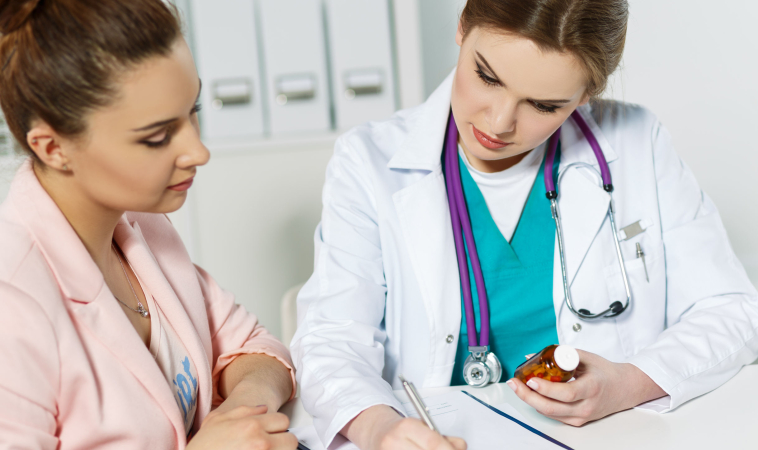Are you experiencing a change to your vaginal discharge? Have you noticed an abnormal vaginal odor or more discharge than usual? If so, you may be experiencing symptoms of a vaginal infection called bacterial vaginosis (BV).
What is BV?
BV is the most common cause of vaginal discharge in women of childbearing age, accounting for 40 to 50 percent of cases. It is an extremely common complaint for the primary care physician and something I see very frequently in my own women’s health and gynecology centered naturopathic practice.
Symptomatic women frequently assume they have a yeast infection, however, the two conditions often present very differently. The most common presentation of BV is an increased thin, watery discharge with a fishy or abnormal odor. Vaginal discomfort can occur but is less common in BV than in yeast vaginitis. Patients with BV may also be asymptomatic although symptoms such as genital burning and/or itching may be present. Yeast, on the other hand, often presents with a thick, white curdy discharge and is often described as painful and itchy. Clinically, it is important to distinguish between the two so that the appropriate treatment can be recommended in order to resolve the infection.
BV is considered a type of vaginitis, or inflammation of the vagina. Effective and lasting treatment for BV is important for women due to the associated increased risk of acquiring a sexually transmitted infection such as HIV, herpes, gonorrhea, chlamydia, and trichomoniasis if a BV infection is present. There is some evidence that BV may also contribute to precancerous cervical lesions and in pregnant women, it has been linked to an increased rate of preterm delivery.
BV is a polymicrobial disease that is commonly thought to occur when the normal protective peroxide producing lactobacilli of the vagina are eliminated or are present in only small amounts. This permits an overgrowth of anaerobic bacteria and other pathogens in the vagina, leading to an increased vaginal pH that favors the proliferation of BV. Chronic or recurrent BV, defined as 3 or more episodes of BV per year, can cause great frustration for both patient and provider alike. In fact, the 6-month recurrence rate for BV has been found to be as high as 80% in some studies.
Because the etiology and pathogenesis of BV is not completely understood, treatment for BV is not always effective and recurrence may occur.
How to treat BV
Conventionally, BV is typically treated with antibiotics, taken orally or applied vaginally as a cream or gel. The most commonly prescribed antibiotics for BV include metronidazole or clindamycin. Both of these drugs can be prescribed as a maintenance or suppressive therapy for long-term use in cases of chronic recurrent BV. For many women, relief from symptoms provided by a single course of antibiotic treatment is often not enough. Approximately half of women who respond to treatment initially will have a recurrence of BV within one year. With this in mind, it becomes clear that additional effective therapies are needed to address the issue of recurrent BV.
Outside of eliminating the known risk factors for BV (sexual intercourse, douching, recent antibiotic use), why is this type of vaginal infection so prone to recur? The explanation for this high rate of recurrence is unclear. Reinfection is possible, but recurrence more likely reflects a failure to eradicate the offending organisms or to reestablish the normal protective vaginal flora. It seems intuitively simple to treat the abnormal overgrowth of anaerobic bacteria, correct the vaginal pH, and call it a day. However, the vaginal environment is more complicated than this. Many clinicians believe that in addition to the reduction in BV-associated bacterial concentration, adequate repletion of the desirable Lactobacillus species must be re-established to fully heal the vaginal microenvironment. This can be accomplished through the initiation of an oral and/or vaginal probiotic, which is a nutritional supplement containing beneficial bacteria that is normally is found in the body. A trained clinician can guide their patients with the selection of the appropriate probiotic, as they are not all created equally. For instance, BV is most often successfully inhibited and treated by certain bacterial species, such as Lactobacillus reuteri and Lactobacillus rhamnosus, as one example. Oral consumption of these specific probiotics has been studied and found to populate the vaginal flora and reduce BV recurrence. It is often recommended that at least four months of oral probiotic administration is needed to fully elucidate this effect.
Newer research in the area of BV has been aimed at the role of biofilm production as a key player in antibiotic resistant BV and its role in recurrence. A biofilm is essentially a highly adherent protective “shell” created by bacteria that provide an anatomic haven protecting bacteria from the effects of antibiotics. The biofilm essentially establishes a foothold in the otherwise hostile environment of the vagina and allows the associated bacteria to thrive. The presence of biofilm development has been observed in several strains of bacteria common to the pathogenesis of BV and has been cited to occur in up to 90% of patients affected by BV.
In women with persistent BV historically treated with antibiotics alone, addressing biofilm development can be an important component of the treatment protocol. The addition of a natural biofilm disruptor may create a more effective antibiotic or natural antimicrobial therapy, increase the likelihood of resolution, and discourage recurrence. While more research is needed, a phase III clinical trial is currently underway evaluating the issue of biofilm development. Vaginal sachets of N-acetylcysteine are currently being investigated as a natural biofilm disruptor; its application with and without Metronidazole is being evaluated for its effect in the treatment of BV and prevention of recurrence. To date, most research on biofilm development in BV has been limited by animal models or in vitro (test tube) studies.
Natural Treatments
For women experiencing side effects of metronidazole treatment or those seeking purely natural treatments, oral garlic tablets may also provide an effective alternative to conventional therapies. A recent randomized clinical trial revealed that a daily garlic tablet taken over 7 days was found to be as effective as oral metronidazole in the treatment of BV. While therapeutic effects of garlic on BV were similar to that of metronidazole, the metronidazole group was associated with more complications and side effects of treatment as compared to those who took garlic.
The addition of boric acid may be an additional treatment option in women with chronic or recurrent BV. Boric acid is specially compounded at a special pharmacy and used as a vaginal suppository only; the frequency and duration of treatment varies depending on the patient’s history and presentation. Utilization of a vaginal boric acid suppository alone or in conjunction with oral metronidazole may improve results and prevent recurrent BV. Additionally, specialty or compounded vaginal suppositories may also be recommended by your naturopathic doctor to treat your infection.
If you suspect you may be experiencing vaginitis, it is extremely important to schedule a visit with your naturopathic physician so that the appropriate diagnosis and treatment recommendations can be made. Natural medicine shines in its ability to offer safe and effective therapeutic options to women experiencing BV for the first time or as a recurrent episode.
 Dr. Michelle Cameron is a licensed naturopathic physician and graduate of the National College of Natural Medicine (NCNM) in Portland, OR, where she received a Doctorate of Naturopathic Medicine in 2013. Following graduation, Dr. Cameron completed a two year-residency program with a primary focus in women’s health and gynecology under the mentorship of Dr. Tori Hudson. She currently maintains a private practice at A Woman’s Time, an integrative natural medicine clinic located in downtown NW Portland.
Dr. Michelle Cameron is a licensed naturopathic physician and graduate of the National College of Natural Medicine (NCNM) in Portland, OR, where she received a Doctorate of Naturopathic Medicine in 2013. Following graduation, Dr. Cameron completed a two year-residency program with a primary focus in women’s health and gynecology under the mentorship of Dr. Tori Hudson. She currently maintains a private practice at A Woman’s Time, an integrative natural medicine clinic located in downtown NW Portland. 
















